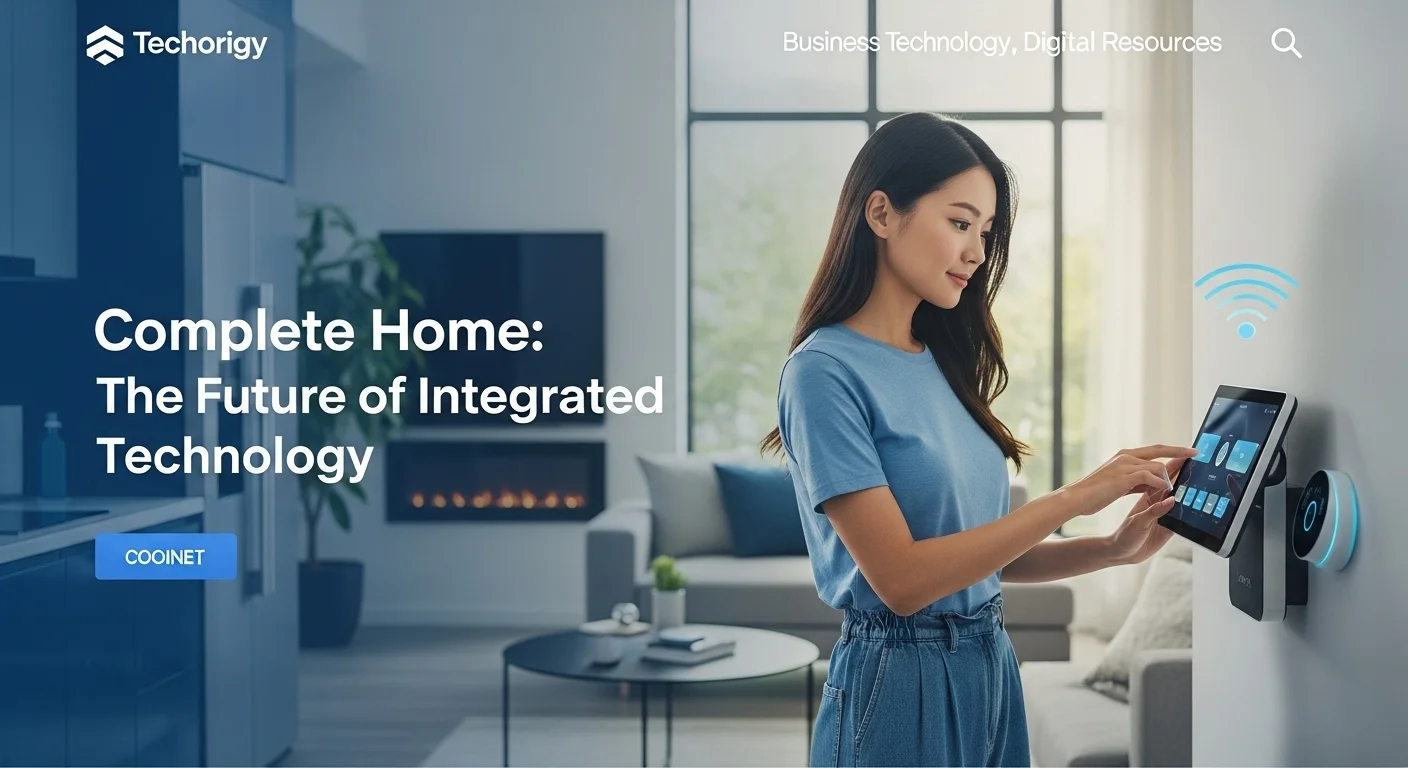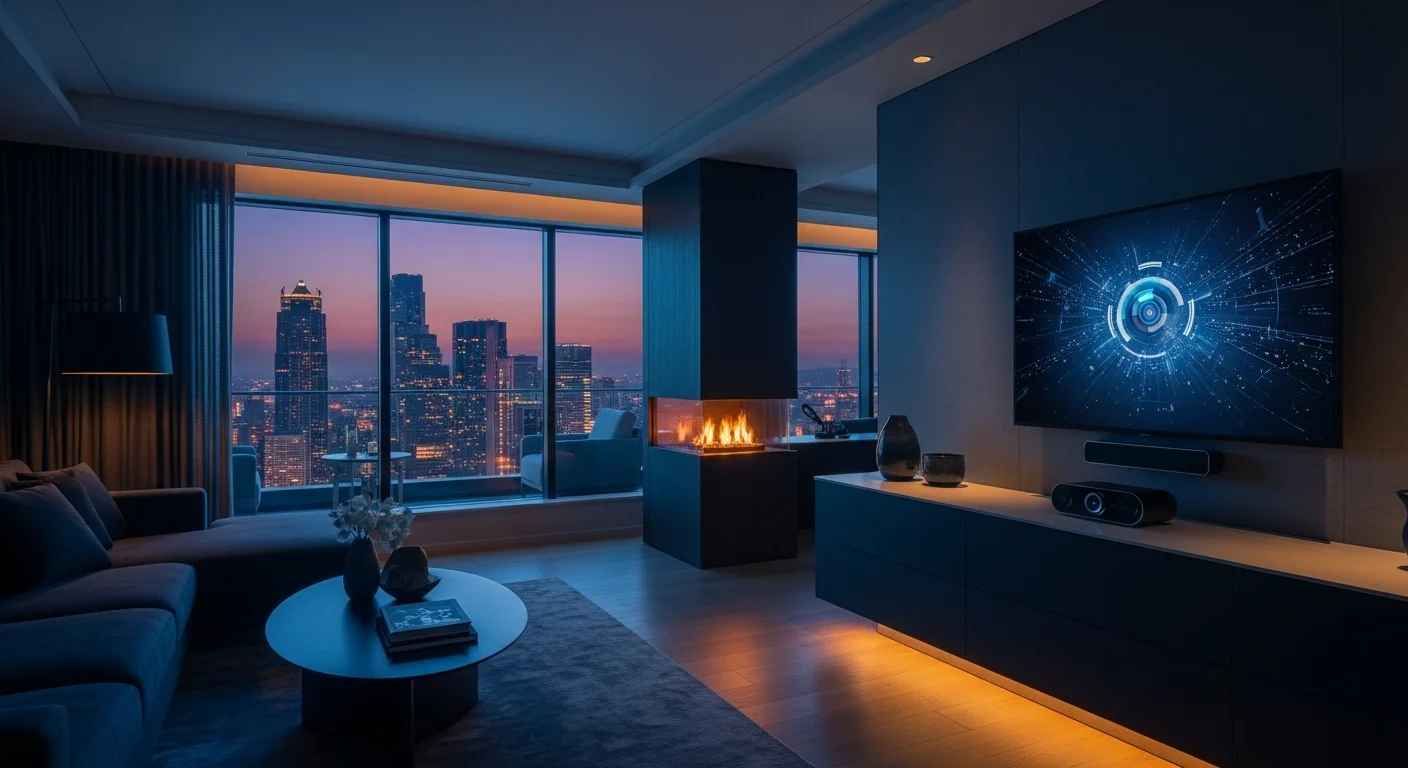The Complete Home: Your Guide to a Truly Smart, Integrated Life

Executive Summary
For years, I've watched people fill their homes with 'smart' gadgets that don’t talk to each other—a smart thermostat here, a video doorbell there. It often creates more digital clutter than convenience. The 'Complete Home' changes all that. It’s not about having more tech; it’s about having your tech work together as one intelligent, seamless system. This article is my personal guide, built from years of experience designing these environments. We'll cut through the jargon to explore how lighting, climate, security, and entertainment can create a home that truly anticipates your needs. For my fellow tech enthusiasts, this is the ultimate sandbox. For business owners, it's a look into the future of real estate, hospitality, and even healthcare. Let’s dive into what makes a home truly smart.
Table of Contents
- What is a Complete Home and Why Does It Matter?
- Business Applications and Untapped Potential
- The Core Benefits of a Unified System
What is a Complete Home and Why Does It Matter?
Let's move past the buzzwords. A 'Complete Home' is simply the next step in home technology. It’s the difference between having a handful of smart devices and living in a smart environment. In my experience, a truly integrated home is one where every piece of technology—from the lights and thermostat to your security cameras and speakers—works together through a central brain. It's not just about telling your speaker to play a song. It's about your house knowing you're waking up and gently raising the blinds, brewing your coffee, and adjusting the temperature without you saying a word. That's the magic of a unified system: it creates a responsive, automated, and personalized experience. This is what we call a holistic approach to home automation, one that values seamless interaction over having a hundred different apps on your phone. The importance of this concept from a tech perspective is huge. It's where major technologies like the Internet of Things (IoT), Artificial Intelligence (AI), and cloud computing finally come together in a practical way. IoT gives us the sensors and gadgets. AI provides the intelligence to learn your habits. And robust networking, using standards like Wi-Fi 6 and Matter, ensures everything communicates instantly and reliably. What this really means is that we're shifting from reactive tech to proactive tech. A basic smart device reacts to your command. An integrated home, on the other hand, learns your patterns and acts on its own. It sees you're driving home and gets the house ready. It detects a small water leak and shuts off the main valve before a disaster happens. That's where the real value is.
Business Applications and Untapped Potential
The rise of the truly connected home is a goldmine for businesses who see the big picture. It’s not just about selling gadgets anymore; it's about creating and managing entire living experiences. Offering complete automation solutions is becoming a massive competitive advantage. Let's look at who's winning:
- Real Estate and Construction: I've seen property values jump when developers build a truly smart home from the ground up. It’s no longer a gimmick; it's a core feature that tech-savvy buyers expect. These homes are more convenient, secure, and energy-efficient, making them an easier sell at a premium price. The market for retrofitting older homes is also enormous.
- Hospitality and Short-Term Rentals: Hotels and Airbnb hosts can completely change the guest experience. Imagine checking in with your phone and the room automatically sets your preferred lighting and temperature. Guests could use their voice to order room service or control the TV. For the business, the energy savings from smart climate control in empty rooms and the streamlined operations from keyless entry are game-changers.
- Healthcare and Assisted Living: This is where I see the most profound impact. A connected home can be a lifeline for the elderly or those with disabilities, allowing for greater independence. Think automated medication reminders, fall detection sensors that alert family or emergency services, and voice controls for everything. This 'Aging in Place' model is a massive opportunity for healthcare and tech companies to offer life-changing services.
- Insurance Industry: Insurance companies are catching on fast. Many now offer big discounts for homeowners with certified smart systems. Why? Because a home that can detect a water leak, smoke, or an intruder and take immediate action prevents billions in claims. Some insurers are even subsidizing the tech, knowing it's a great investment against risk.
- Energy and Utilities: This is a win-win. Utility companies can work with smart homes to manage grid load during peak hours, offering customers rebates for letting their thermostat adjust by a degree or two. This prevents blackouts and builds a more stable grid. Plus, homeowners get detailed reports on their energy use, empowering them to save money and live more sustainably.
The Core Benefits of a Unified System
When all your home's technology works as a team, the benefits go far beyond simple convenience. It fundamentally improves your quality of life. Here's what I've seen people value most:
- Effortless Convenience: This is the most obvious perk. Controlling everything from one app or with your voice is a huge time-saver. But automation is where it shines. A single 'Goodbye' command can lock up, arm the security, kill the lights, and set back the thermostat. It's about eliminating dozens of tiny tasks that add up every day.
- Real Security and Peace of Mind: An integrated system offers security that standalone devices can't touch. When your door sensor, cameras, and lights all talk to each other, you can create powerful deterrents. If a sensor is tripped at night, the system can flick on every light in the house, sound an alarm, and instantly send a video feed to your phone. That's real peace of mind.
- Serious Energy and Cost Savings: This is what often convinces people to invest. A smart thermostat that learns your schedule can slash heating and cooling bills. Automated lights and blinds that work together to use natural light and heat efficiently make a huge difference. Over time, a well-designed system pays for itself in savings.
- Proactive Home Maintenance: A truly smart system doesn't just react; it anticipates. It can detect a slow leak in your water heater or an error code in your furnace before it becomes a catastrophic failure. This predictive ability saves homeowners from massive headaches and emergency repair bills.
- A Home That Adapts to You: The best systems learn your preferences for light, temperature, and even music throughout the day. Some can even recognize who is in the room and adjust the environment for them. As your life changes, the system can be reconfigured, ensuring it's always working for you, not the other way around.

A Practical Guide to Complete Home Technology and Business Solutions
Building a great integrated home isn't about buying the most expensive gear; it's about making smart, strategic choices. You have to understand the technology layers, the platforms that run the show, and how to approach it whether you're a homeowner or a business. This is my guide to navigating the complex but rewarding world of home automation.
Technical Methods: The Building Blocks of a Connected Home
I like to think of a smart home's architecture in layers, like building a house. If you get the foundation right, everything else will be solid, reliable, and secure.
1. The Connectivity Layer: How Devices Talk
This is the foundation. It's the invisible network that lets your devices communicate. Most homes use a mix of these, and a good central hub is the key to making them work together.
- Wi-Fi: The superhighway for your data-hungry devices like cameras, TVs, and voice assistants. Wi-Fi 6 is the modern standard you want, as it's built to handle a house full of gadgets without slowing down.
- Bluetooth: Perfect for short-range devices that don't need a lot of power, like smart locks or individual light bulbs. It's efficient and lets them run on batteries for ages.
- Zigbee & Z-Wave: These are the local neighborhood streets. They create a 'mesh' network where devices can pass signals to each other, which is fantastic for spreading sensors throughout a large house without worrying about range. They are low-power and very reliable.
- Thread: Another mesh network like Zigbee, but it's built on the same language as the internet (IP). This makes it easier for Thread devices to talk directly to your Wi-Fi devices without complex translation.
- Matter: This is the universal translator. For years, the biggest headache was that devices from different brands refused to work together. Matter, which is backed by Apple, Google, and Amazon, fixes that. If a device has the Matter logo, it will work with any Matter controller. This is a complete game-changer for building a flexible and future-proof system.
2. The Control Layer: The Brains of the Operation
This is the central hub that manages all your devices and runs your automations. Choosing your main ecosystem is one of the most important decisions you'll make.
- The Mainstream Players (Alexa, Google, Apple):
- Amazon Alexa: King of voice control. If you want to talk to your house and have the widest possible selection of compatible gadgets, Alexa is a great choice. Its 'Routines' are simple to set up but very powerful.
- Google Home/Assistant: I've found Google Assistant is often a bit smarter at understanding natural, conversational language. It's a natural fit if you're already in the Android and Google ecosystem.
- Apple HomeKit: This is the platform for those who prioritize privacy and security above all else. The user experience is incredibly polished and seamless if you're an Apple user. While it used to have fewer compatible devices, Matter is quickly changing that.
- For the Power Users & Tinkerers:
- Home Assistant: This is my personal favorite for ultimate control. It's open-source software you run yourself on a small computer. It works with thousands of devices and lets you build automations of incredible complexity. Best of all, it runs locally, making it super fast and private, with no reliance on the cloud.
- Samsung SmartThings: A great platform that strikes a balance between user-friendliness and power. It has built-in support for multiple protocols and has a strong automation engine.
Business Techniques for Deploying Smart Home Solutions
For businesses, selling and installing these systems is about more than just the tech. It’s about being a trusted consultant and building long-term value for your clients.
1. Consultation, Not Just Sales: The first conversation I always have with a client is about their lifestyle and goals. Are they focused on security? Saving energy? Making life easier with kids? You have to design a solution that fits them, not just sell a pre-packaged box. A custom-tailored plan is always the best approach.
2. Phased Rollouts: Not everyone can afford a full-system install at once. A smart business strategy is to offer a foundational package—great networking, a solid hub, and maybe some smart lighting—and then create a roadmap for future upgrades. This builds an ongoing relationship.
3. The Shift to Services: The real money isn't just in hardware. It's in recurring revenue. This includes monthly fees for professional security monitoring, ongoing tech support and maintenance plans, and cloud storage for video cameras. For commercial clients, you can even manage their entire ecosystem as a service.
4. Sell Security as a Core Feature: In today's world, cybersecurity is non-negotiable. I tell my clients that a secure system is a core feature, not an add-on. This means building a reputation for secure installs: using separate networks for IoT devices, enforcing strong passwords, and keeping everything updated. Offering a 'cybersecurity health check' is a great value-add.
Resource Comparisons: Making the Right Choice
Deciding on the right path for your smart home involves a few key trade-offs.
DIY vs. Professional Installation:
- DIY: Perfect for the tech-savvy person on a budget who loves to tinker. You can build an incredibly powerful system with platforms like Home Assistant. The catch is the steep learning curve and the time you'll invest in setup and troubleshooting. You're your own tech support.
- Professional Installation: If you just want a system that works flawlessly without the headaches, hire a pro. They will design a robust system, make sure everything works together, and provide support. The upfront cost is higher, but it can save you a world of frustration.
Cloud vs. Local Control:
- Cloud-Based: Systems like Alexa and Google rely on cloud servers. This gives them powerful AI and easy remote access. The downsides are that your automations might fail if your internet goes out, and you have to trust the company with your data.
- Local Control: Platforms like Home Assistant process everything inside your own home. This makes automations faster, more reliable, and far more private. In my opinion, the best systems use a hybrid approach: keep critical automations local, but use the cloud for things like voice control.
By understanding these building blocks and strategies, you can make informed decisions to create a powerful, reliable, and secure system that genuinely improves modern life.

Actionable Tips for a Better Smart Home Experience
Getting a Complete Home up and running is one thing; making it a truly exceptional and reliable part of your life is another. It comes down to smart planning, following best practices, and using the right tools. Here are the tips and strategies I share with all my clients to help them get the most out of their investment in home automation.
Best Practices for a Superior Smart Home
These are the foundational rules. Follow them, and you'll build a system that's powerful, reliable, and secure from day one.
1. Build on a Rock-Solid Network Foundation:
I can't stress this enough: your network is the central nervous system of your smart home. A cheap or old router is the #1 cause of frustration.
- Get a Modern Router: Invest in a Wi-Fi 6 (or newer) router. They are designed specifically to handle dozens of devices at once without getting bogged down.
- Use a Mesh System: For any home over 1,500 sq ft or with multiple floors, a single router won't cut it. A mesh system uses several points around your house to blanket it in strong, seamless Wi-Fi, killing dead zones for good.
- Separate Your Networks: This is a pro-level security tip that's easy to do. Most modern routers let you create a 'guest' network. Put all of your smart home gadgets on this separate network. This isolates them from your personal computers and phones, so if one device is ever compromised, it can't access your sensitive data.
2. Think Ahead with Interoperability:
The old nightmare of smart homes was being locked into one brand. The future is all about open standards.
- Demand Matter: When buying new gear, look for the Matter logo. This is your guarantee that it will work with other Matter devices, no matter who makes them. It's the key to a flexible, future-proof home.
- Get a Multi-Talented Hub: Choose a central controller that can speak multiple languages (Wi-Fi, Zigbee, Z-Wave, Thread). This gives you the freedom to use the best device for the job, even if it's an older or more specialized gadget that doesn't support Matter yet.
3. Create Automations That Actually Help:
The real power of a connected home is in its automations. Go beyond simple voice commands and build routines that solve real problems.
- Use Scenes for Activities: A 'Movie Night' scene can dim the lights, turn on the TV, and lower the shades with one tap. A 'Focus' scene for your home office can set the lights to a cool white and silence distracting notifications.
- Let Your House React to You: Use motion or presence sensors to have lights turn on and off automatically as you move through the house. Use your phone's location (geofencing) so the thermostat goes into energy-saving 'away' mode when you leave and gets comfortable again as you approach home.
- Layer Your Security: Think beyond just an alarm. If a camera spots a person in your yard at night, have it trigger the floodlights, play a recording of a dog barking, and send an alert to your phone. This proactive response is what makes a security system truly smart.
4. Be Disciplined About Cybersecurity:
Securing your smart home is as important as locking your front door. It’s not something to do 'later'.
- Change Every Default Password: This is rule number one. Default passwords are a massive security hole. Change them on every single device you install.
- Use a Password Manager: Don't reuse passwords. Use a password manager to generate and store long, unique, complex passwords for every smart home account.
- Enable Two-Factor Authentication (2FA): Turn this on for your main smart home accounts (Apple, Google, Amazon). It's the single best thing you can do to protect your accounts, even if someone steals your password.
- Keep Everything Updated: Manufacturers release firmware updates to patch security flaws. Make it a habit to check for and install these updates regularly.
Business Tools and Tech Experiences
For professionals in this space, using the right tools separates the amateurs from the experts. For homeowners, knowing these exist can help you vet your installer.
- System Design Software: Pros use tools like D-Tools to map out every wire and device. This ensures a clean installation and provides you with a blueprint for future upgrades.
- Network Analyzers: These tools help installers find the perfect spot for Wi-Fi nodes and eliminate interference, guaranteeing a flawless network.
- Project Management Platforms: For larger projects, software like Asana helps coordinate the entire job, ensuring electricians, network installers, and other specialists are all on the same page.
Ultimately, a successful smart home tells a story. It's the story of a family waking up to gentle light and a warm house. It's the story of getting a notification that your kids arrived home safely from school because their unique code unlocked the door. It's the peace of mind knowing your home is secure and efficient, working quietly in the background to make your life just a little bit easier. That seamless integration is the true goal.
Quality External Resources
To stay on top of the rapid changes in this field, it's vital to consult high-quality sources. For deep dives into the AI and IoT technologies that fuel the modern smart home, I always recommend keeping an eye on the Artificial Intelligence section on TechCrunch. They offer expert analysis on where this technology is headed.
By following these tips and staying informed, you can ensure your smart home is more than just a collection of gadgets—it's an intelligent, intuitive, and secure environment that enhances your daily life.
Expert Reviews & Testimonials
Sarah Johnson, Business Owner ⭐⭐⭐
As a business owner, I found this a solid overview. I would have loved a few more real-world case studies for commercial applications, but the foundation is strong.
Mike Chen, IT Consultant ⭐⭐⭐⭐
A really helpful article that clarifies the 'Complete Home' concept. As an IT consultant, I appreciated the technical breakdown, though a simpler explanation of the protocols might help beginners.
Emma Davis, Tech Expert ⭐⭐⭐⭐⭐
Fantastic and comprehensive guide! This piece on the Complete Home was incredibly useful for my specialization. It connected all the dots for me perfectly. Highly recommended!



